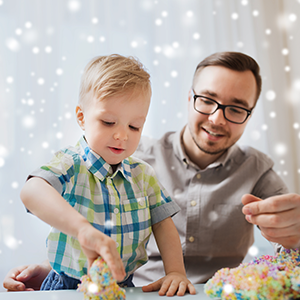To keep your children’s hands and minds busy indoors while it’s frigid outside, try these four flakey activities.
FOREVER FROSTY
Supplies
- 4 cups flour
- 1 cup salt
- 1 ½ cups water
- 2 tablespoons white tempera paint
- Mixing bowl
- Mixing spoon
- Small items for embellishment (twigs, dried beans, beads, buttons, etc.)
- Conventional oven, 250 degrees
- White glue
- Paintbrush
- White or iridescent glitter
- Acrylic sealer-matte (optional)
Instructions
- Mix flour, salt, water and tempera paint. Knead until dough is smooth.
- Form dough into balls to create a snowman.
- Use twigs for arms, dried beans or colorful beads for eyes and other small embellishments to give your snowman personality.
- Place on a cookie sheet and bake for 30 minutes. Thereafter, check every five minutes until the dough dries out. Remove from the oven and cool. (Or air-dry for several days to prevent puffiness that sometimes occurs with baking.)
- Brush the snowman’s body with glue, then sprinkle with glitter and shake off excess.
- To preserve your snowman indefinitely, apply an acrylic sealer-matte to the entire surface.
BLIZZARD IN A BOTTLE
Supplies
- Clean, clear glass jar with a watertight lid (baby food or jelly jar)
- Glue gun (low setting)
- Small snowman ornament (must fit inside the jar)
- Water
- 1 tablespoon glycerin
- 2 tablespoons iridescent glitter and/or white plastic confetti
Instructions
- Glue snowman to the inside of the jar lid.
- Fill the jar 3/4 full of cool water.
- Add 1 tablespoon of glycerin (this will slow the “snow” falling) and 2 tablespoons of glitter and/or confetti.
- Apply glue to the inside rim of the lid and immediately place over the jar to seal.
SUGARY SNOWFLAKE
Supplies
- Large flour tortilla
- Microwave oven
- Scissors
- Vegetable spray
- Conventional oven, 425 degrees
- Confectioner’s sugar
- Edible glitter (optional)
Instructions
- Place one tortilla in the microwave for several seconds on low power to soften.
- While the tortilla is still warm, fold it in half and then in half again to create a wedge shape. Use scissors to cut out circles, triangles and scalloped edges as if you were making a paper snowflake.
- Open the tortilla snowflake and lightly spray with vegetable oil.
- Place it on a cookie sheet and bake three minutes or until light brown and crispy.
- Remove from the oven and sprinkle with confectioner’s sugar and edible glitter. Eat and enjoy!
BATIK BOOK BAG
Supplies
- Plain canvas tote bag
- Permanent marker
- Paper
- Cardboard
- Tacky glue
- Small sponge brush
- Wintry, pastel-colored fabric paint
Instructions
- With the marker and paper, draw a large snowflake to create a template for your book bag design.
- Place cardboard inside the tote bag so the paint won’t bleed through to the back side.
- Working from the front center of the bag, use tacky glue to duplicate your design onto the tote bag. Let glue dry for three to four hours until it is transparent.
- Use the sponge brush to lightly dab paint over the snowflake, bringing the color to the outer edges of the design. Let dry.
- Place the bag in warm water for approximately 10 minutes until the glue softens and can be peeled off.
- Follow manufacturer’s instructions for setting the fabric paint.
SNOWFLAKE SCIENCE
Until 1880 we knew very little about snowflakes. But thanks to a Vermont man named Wilson Bentley, we now understand more about these falling flakes. One day “Snowflake” Bentley, as he was affectionately called, took a microscope outside and began viewing snowflakes up close. Captivated by their unique beauty, he purchased a camera and took pictures so he would have a permanent record of them. For the next 40 years Bentley studied snowflakes, capturing over 5,000 images and developing a system for categorizing more than 80 different types of flakes.
Later, meteorologists perfected Bentley’s research and discovered that factors such as air current, humidity and dirt particles trapped in the water vapor affect the type of flake formed. Cloud location does too. High clouds, where the temperature is coolest, produce one type of flake; mid-flying clouds produce another. Low clouds, where it’s warmer, produce yet another type and are the largest flakes of all. Snowflakes are typically about a half inch, but the largest ones range between three and four inches. Shapes vary too, though the most common is a hexagonal (six-sided) prism. In fact, no two snowflakes are alike.
If you want to be a snowflake scientist, cover a piece of cardboard with black felt and place it in the freezer for 30 minutes. Then grab a magnifying glass and take your equipment outside to catch and view flakes that fall from the sky.
ARCTIC READS
- “The Biggest, Best Snowman” by Margery Cuyler.
- “Blizzard” by Carole Gerber.
- “Clifford’s First Snow Day” by Norman Bridwell.
- “Geraldine’s Big Snow” by Holly Keller.
- “Good Citizen Sarah” by Virginia Kroll.
- “It’s Snowing! It’s Snowing!” Winter Poems by Jack Prelutsky.
- “Snow Amazing: Cool Facts and Warm Tales” by Jane Drake and Ann Love.
Related Articles
Snow Day Activities With Kids in the Kitchen
Winter Activities that will Keep Your Kids from Bouncing Off the Walls

